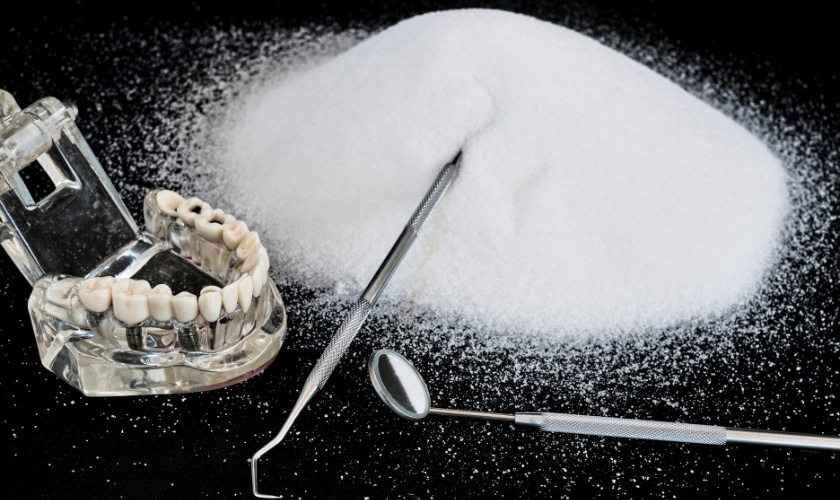Maintaining bright and white teeth is a common goal for many individuals, as it not only enhances one’s appearance but also boosts self-confidence. Among various home remedies for teeth whitening, salt has been mentioned frequently as a natural solution to remove stains from teeth. This article explores whether salt is truly effective in teeth whitening, its benefits, potential risks, and alternative options for a brighter smile.
Understanding Tooth Stains
Before delving into the effectiveness of salt for teeth whitening, it’s essential to understand the types of tooth stains:
- Extrinsic Stains: These external elements, which include coffee, tea, red wine, tobacco, and specific meals, are typically the cause of these stains on the outer layer of teeth.
- Intrinsic Stains: These stains occur within the tooth structure and can result from factors like aging, trauma, excessive fluoride exposure, or certain medications.
How Does Salt Work on Teeth?
Salt, primarily composed of sodium chloride, is an organic abrasive that might aid in getting rid of surface spots on teeth. Here’s how it works:
- Abrasive Action: The gritty texture of salt can help scrub away plaque and surface stains on the enamel when used as a gentle scrub.
- Antibacterial Properties: Salt naturally possesses antimicrobial properties that can reduce oral bacteria, potentially leading to a cleaner mouth.
- Increase in Saliva Production: Rinsing with salt water may increase the production of saliva, which naturally cleans the mouth and may help prevent plaque buildup.
Using Salt for Teeth Whitening
While salt can have some impact on surface stains, it’s important to use it cautiously to avoid damaging your teeth. Here are some methods and tips for using salt safely:
Salt and Water Rinse
- Mix one teaspoon of salt in a glass of warm water. Use this mixture to rinse your mouth for about 30 seconds. This can help remove loose particles and freshen your breath.
- Use once or twice a week. Overuse of saltwater rinses can lead to enamel erosion, so it’s best to limit its use.
Salt and Baking Soda Paste
- Combine equal parts salt and baking soda with a few drops of water to form a paste. It may increase the production of saliva, which naturally cleans the mouth and about one to two minutes.
- Use sparingly. Baking soda is also abrasive, and excessive use can harm the enamel.
Salt and Lemon Juice Mixture
- Mix a small amount of salt with lemon juice to create a paste. Apply it to your teeth using a soft-bristled toothbrush.
- Limit use to once a week. Because lemon juice is so acidic, it can erode enamel if used frequently.
Benefits of Using Salt for Teeth Whitening
Salt has several potential benefits when used appropriately:
- Cost-effective: Salt is an affordable and easily accessible option for at-home oral care.
- Natural and chemical-free: Unlike some commercial whitening products, salt is a natural substance without added chemicals.
- Mild antibacterial effects: Salt can help reduce oral bacteria, contributing to overall oral health.
Potential Risks and Drawbacks
While salt can offer some benefits, there are potential risks and drawbacks to consider:
- Enamel Erosion: Over time, the abrasive properties of salt can erode tooth enamel, resulting in increased sensitivity and vulnerability to cavities.
- Gum Irritation: Excessive use of salt can aggravate the mouth’s soft tissues, including the gums.
- Limited Effectiveness: Salt primarily addresses extrinsic stains, and its impact on intrinsic stains is minimal.
Alternative Teeth Whitening Options
If you’re looking for more effective and safer ways to whiten your teeth, consider these alternatives:
Professional Teeth Whitening
- In-office treatments: Dentists offer professional whitening procedures that use high-concentration bleaching agents for fast and effective results.
- Custom-fitted trays: Dentists can provide take-home kits with custom-fitted trays and professional-grade whitening gel.
Over-the-counter Whitening Products
- Whitening toothpaste: Toothpaste containing mild abrasives and chemical agents can help remove surface stains with regular use.
- Whitening strips and gels: These products contain peroxide-based bleaching agents that can lighten extrinsic and some intrinsic stains.
Natural Remedies
- Oil pulling: Floating coconut oil around the palate for several minutes daily can help reduce bacteria and plaque, leading to a brighter smile.
- Activated charcoal: This natural substance can help absorb surface stains, but it should be used sparingly to avoid enamel damage.
While salt can provide some benefits in terms of removing surface stains and maintaining oral hygiene, It isn’t a complete teeth-whitening treatment. Its abrasive nature can pose risks to tooth enamel and gum health if used excessively. For those seeking effective and lasting results, professional teeth whitening treatments or approved over-the-counter products are recommended.
Always consult with a dentist before trying new teeth whitening methods to ensure they are safe and suitable for your oral health needs. By maintaining good oral hygiene practices and considering professional guidance, you can achieve a brighter, healthier smile.

